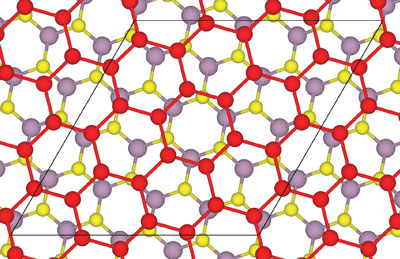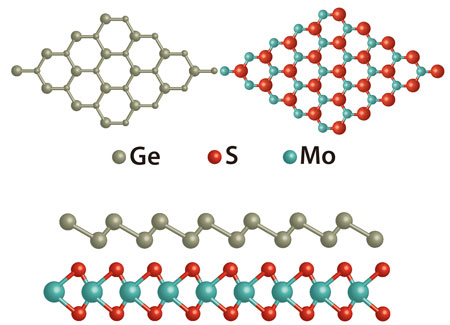| Posted: Jun 22, 2016 |
Proper breeding ground for germanene
(Nanowerk News) Germanene is a one atom thick sheet of germanium, in a honeycomb structure. It has clear similarities with graphene, the material that induced massive research activity worldwide, especially after 2010’s Nobel Prize.
|
|
A major difference between graphene and germanene is the ‘band gap’, a property well-known in semiconductor electronics: thanks to this ‘jump’ of energy levels that electrons are allowed to have, it is possible to control, switch and amplify currents. Graphene had a very small band gap that can only be measured at very low temperatures, germanene shows a band gap that is significantly larger.
|
 |
| Germanene honeycombe on MoS2.
|
|
Previous attempts to grow germanene, however, show that these attractive properties seem to vanish when it is grown on a metal surface: a good conductor of current. To prevent this, the UT scientists chose the semiconductor MoS2 as the substrate material (Physical Review Letters, "Structural and Electronic Properties of Germanene on MoS2").
|
|
Islands
|
|
Under ultra-high vacuum conditions, germanene indeed grows on the semiconductor. At first, the scientists observed islands at the locations where MoS2 had crystal defects, after that the germanene is spreading out covering a larger surface. An exciting question is, if the desired properties remain intact. First measurements show that the typical 2D properties and band gap are present, further low temperature measurements are needed to confirm germanene operates in the desired way: the inner part would work as an insulator, while conducting channels are formed at the edges.
|
 |
| Germanene on MoS2.
|
|
Sandwich
|
|
The other UT scientists did quantum mechanical calculations on the molybdenum-disulfide combination (Physical Review Letters, "Ζ2 Invariance of Germanene on MoS2 from First Principles"). They, for example, looked at the direction of growth, to be able to optimize the process. The theoretical group went one step further, by not only investigating the bilayer of molybdenum-disulfide, but als covering the germane with molybdeendisulfide. This prevents germanene from rapid oxidation. Calculations show that the sandwich construction has even better performance when it comes to the band gap.
|
|
Both publications show dat germanene, grown on molybdenum-disulfide is an important first step towards new electronic devices or unsuspected combinations with conventional devices. ‘Spintronics’, based on the spin movement of electrons, seems to be an attractive application area for germanene. Electrons with spin up and electrons with spin down have separate conducting channels on the edges of germanene. Harold Zandvliet recently received a grant for further research on this promising effect.
|


